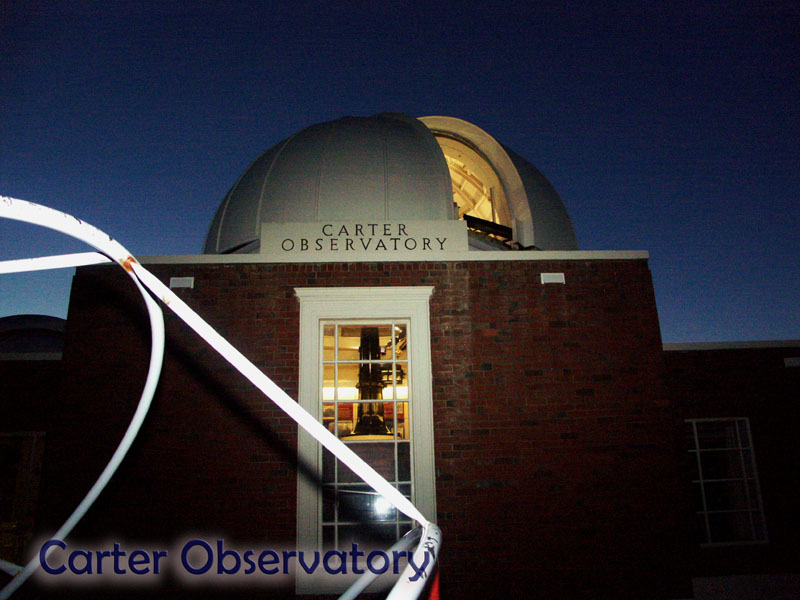- Carter Observatory
Infobox Historic building
name =Carter Observatory
caption =The Carter Observatory, showing the Thomas Cooke telescope dome
map_type =
latitude =-41.28437
longitude =174.76697
location_town = Wellington
location_country =New Zealand
architect =
client =
engineer =
construction_start_date = 1937
completion_date = 1941
date_demolished =
cost =
structural_system =
style =
size = The Carter Observatory stands at the top of the Botanic Gardens inWellington ,New Zealand . It is closed for refurbishment and will re-open in Summer 2008/9 with a new exhibition celebrating the culture, heritage and science of the southern skies.The redevelopment is being managed by Wellington City Council [http://www.wellington.govt.nz/] on behalf of the Carter Observatory Board.
History
The name commemorates
Charles Rooking Carter , who gifted his estate to what later became theRoyal Society of New Zealand for the purposes of establishing an astronomical observatory in or near Wellington. Parliament established the Carter Observatory in 1937; it opened in 1941, following some delays caused by the beginnings ofWorld War II .The observatory became a base for astronomical research in New Zealand. Research began with solar investigations and when new staff joined during the 1970s it expanded to
variable star s, galaxies,comet s andasteroid s. The observatory has had formal research programmes and assists amateur astronomers to perform their own research.The Carter Observatory became New Zealand's National Observatory in 1977. In recent years, its role "shifted from a focus on research to increasingly concentrate on public education about space" [ See: Assessment of New Zealand's National Observatory Needs] [http://www.morst.govt.nz/publications/policy-discussions/national-observatory-assessment/] .
The Ministry of Research, Science and Technology [http://www.morst.govt.nz/] commissioned astronomer Professor Mike Bessell,
Australian National University , to review Carter Observatory’s ability to carry out its functions as New Zealand's National Observatory, to explore New Zealand’s requirements and the opportunities in the National Observatory area, and assess the roles of the various players within the sector. Professor Bessell's report was published in February 2005: [http://www.morst.govt.nz/Documents/publications/discussions/National-Observatory-Assessment-report.pdf]In 2006, the Carter Observatory Board announced plans to refurbish the Observatory and create an international-quality visitor attraction and astronomy education resource. Carter's permanent staff were made redundant as "the changing nature of the observatory means there will be fewer jobs available once it has been refurbished." [http://stuff.co.nz/4332714a6000.html] .
The Observatory will re-open in Summer 2008/9 with a new exhibition celebrating the culture, heritage and science of the southern skies.
The redevelopment is being managed by Wellington City Council [http://www.wellington.govt.nz/] on behalf of the Carter Observatory Board.
Facilities
The Carter Observatory houses two main
telescope s within its main building and a third telescope nearby. The Thomas Cooke telescope, an historic 9 3/4-inch Cooke Refractor named afterThomas Cooke , serves primarily for public observing sessions. The Ruth Crisp telescope, described below, arrived as a donation in the 1960s. Not far from its main building, the Carter Observatory operates the Thomas King Observatory, used until recently for public viewing of thesun .The Ruth Crisp telescope
The Ruth Crisp telescope, a research-grade 41-cm (16-inch) reflecting telescope made by Boller and Chivens of the
USA , came to the observatory in the 1960s thanks to a donation byRuth Crisp . Once used for research at the Carter Observatory's outstation at Black Birch, in theSouth Island of New Zealand, it later moved to the main premises in Wellington.A grant from
Pub Charity allowed improvements to the installation in December 2005: the Observatory had the dome motorised and the primary and secondary mirrors re-aluminised. Efforts have commenced to start a research programme based around the facility, possibly involving deep-sky imaging, microlensing capability and photometry.The Thomas King Observatory
The Carter Observatory also operates the nearby Thomas King Observatory. Astronomers have maintained its 12.5 cm (5-inch) telescope (made in 1882 by Grubb in Dublin) in good condition throughout its nearly 125-year history.
Last refurbished in May 2001, the Thomas King telescope served until recently for public viewing of the
sun , with a hydrogen-alpha filter attached. The filter has since transferred to a telescope mounted to the side of the Thomas Cooke refractor in the main observatory building.Current operations
The Carter Observatory is closed for refurbishment and will re-open in Summer 2008/9 with a new exhibition celebrating the culture, heritage and science of the southern skies.
The redevelopment is being managed by Wellington City Council [http://www.wellington.govt.nz/] on behalf of the Carter Observatory Board.
Events
In 2006 several hundred visitors enjoyed a "Saturn weekend" of lectures and viewing. Viewers at all three observatories could clearly see the
Cassini Division and the cloud bands. A small historic telescope, similar to that used by Galileo, also served for public viewing — a fitting tribute to the astronomer who first saw therings of Saturn in 1610.Recent events at Carter Observatory have included musical performances, seminars and celebrations of "Mata Ora", the time of the Polynesian migration to
Aotearoa . Maori navigation and star-lore have figured increasingly in discussions about astronomy in New Zealand.Gallery
See also
*
Gifford Observatory , also located in Wellington
*Ruth Crisp (discussion on the Boller and Chivens telescope and the Ruth Crisp facility)
*Thomas King (New Zealand)
*Carter Observatory, Black Birch Station References
External links
* [http://www.carterobservatory.org/ The Carter Observatory's main website]
* [http://www.wellington.govt.nz/ Wellington City Council website]
Wikimedia Foundation. 2010.
